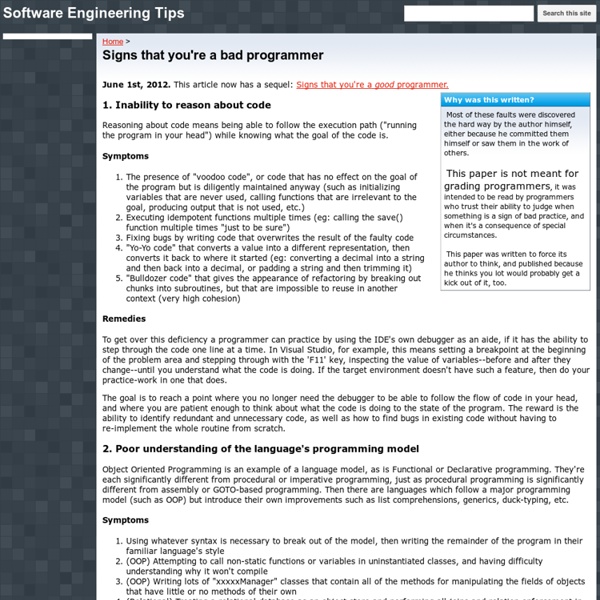What every computer science major should know
Portfolio versus resume Having emerged from engineering and mathematics, computer science programs take a resume-based approach to hiring off their graduates. A resume says nothing of a programmer's ability. Every computer science major should build a portfolio. A portfolio could be as simple as a personal blog, with a post for each project or accomplishment. A better portfolio would include per-project pages, and publicly browsable code (hosted perhaps on github or Google code).
Signs that you're a good programmer - Software Engineering Tips
The most frequently viewed page on this site is Signs you're a bad programmer, which has also now been published on dead trees by Hacker Monthly, and I think that behoves me to write its antithesis. "Bad programmer" is also considered inflammatory by some who think I'm speaking down to them. Not so; it was personal catharsis from an author who exhibited many of those problems himself. And what I think made the article popular was the "remedies"--I didn't want someone to get depressed when they recognized themselves, I wanted to be constructive. Therefore if you think you're missing any of the qualities below, don't be offended. I didn't pick these up for a while, either, and many of them came from watching other programmers or reading their code.
Singleton Pattern - Web Tutorials - avajava.com
Singleton Pattern Author: Deron Eriksson Description: This Java tutorial describes the singleton pattern, a popular creational design pattern. Tutorial created using: Windows Vista || JDK 1.6.0_11 || Eclipse JEE Ganymede SR1 (Eclipse 3.4.1) A singleton is a class that is instantiated only once. This is typically accomplished by creating a static field in the class representing the class.
Extreme Programming Rules
Planning User stories are written. Release planning creates the release schedule. Make frequent small releases. The project is divided into iterations.
Humor - How to Shoot Yourself In the Foot Using Any Programming Language
The proliferation of modern programming languages (all of which seem to have stolen countless features from one another) sometimes makes it difficult to remember what language you're currently using. This guide is offered as a public service to help programmers who find themselves in such dilemmas. 370 JCL You send your foot down to MIS with a 4000-page document explaining how you want it to be shot. Three years later, your foot comes back deep-fried. Ada After correctly packaging your foot, you attempt to concurrently load the gun, pull the trigger, scream, and shoot yourself in the foot. When you try, however, you discover that your foot is of the wrong type.
Don't Call Yourself A Programmer, And Other Career Advice
If there was one course I could add to every engineering education, it wouldn’t involve compilers or gates or time complexity. It would be Realities Of Your Industry 101, because we don’t teach them and this results in lots of unnecessary pain and suffering. This post aspires to be README.txt for your career as a young engineer.
Scripting Languages: PHP, Perl, Python, Ruby, Smalltalk
a side-by-side reference sheet sheet one: version | grammar and execution | variables and expressions | arithmetic and logic | strings | regexes | dates and time | arrays | dictionaries | functions | execution control | exceptions | threads sheet two: streams | asynchronous events | files | file formats | directories | processes and environment | option parsing | libraries and namespaces | objects | inheritance and polymorphism | reflection | net and web | gui | databases | unit tests | logging | debugging sheet two: streams | asynchronous events | files | directories | processes and environment | option parsing | libraries and namespaces | objects | inheritance and polymorphism | reflection | net and web | gui | databases | unit tests | logging | debugging version used The versions used for testing code in the reference sheet.
Invent Your Own Computer Games with Python - Chapters
Chapter 1 Read online: Chapter 1 - Installing Python Videos: Chapter 2 Read online: Chapter 2 - The Interactive Shell Chapter 3
The Evolution of a Programmer
High School/Jr.High First year in College program Hello(input, output) begin writeln('Hello World') end.



